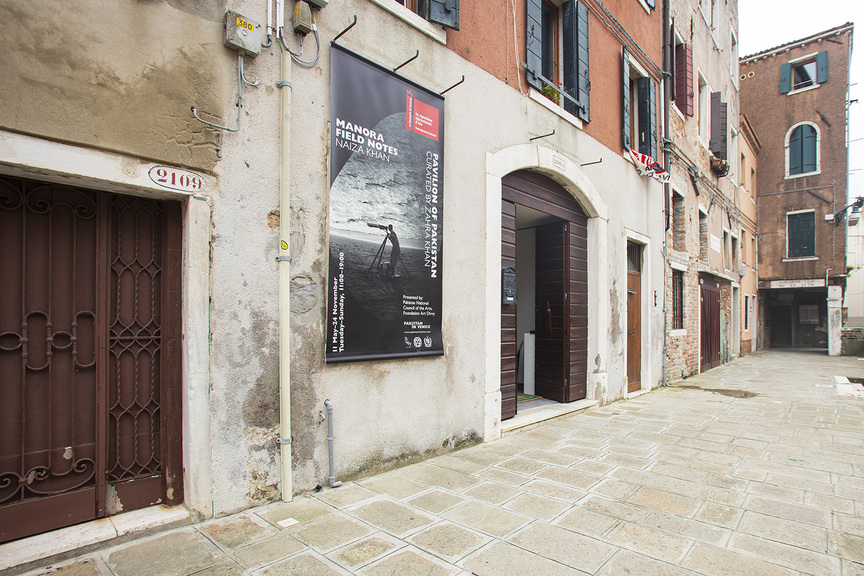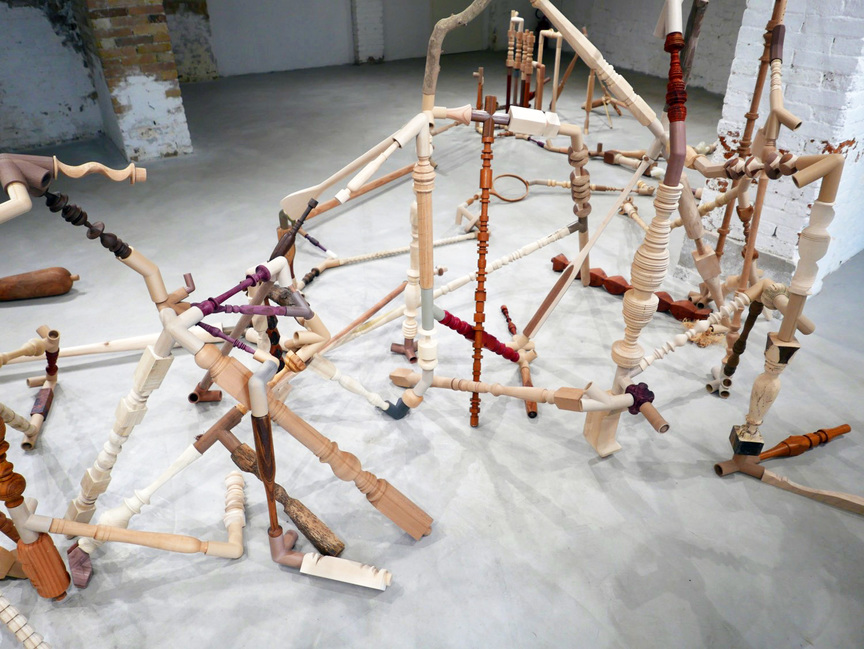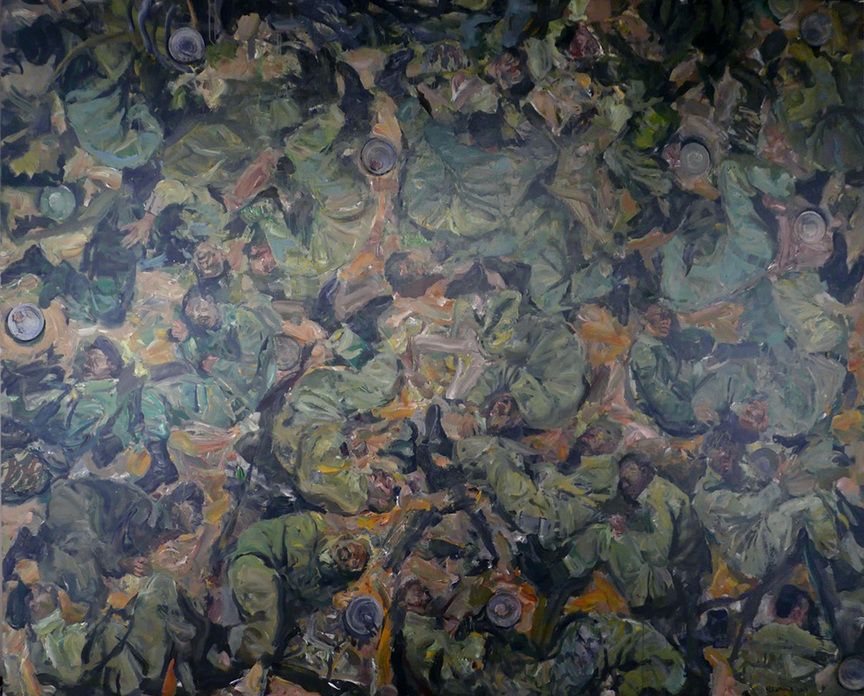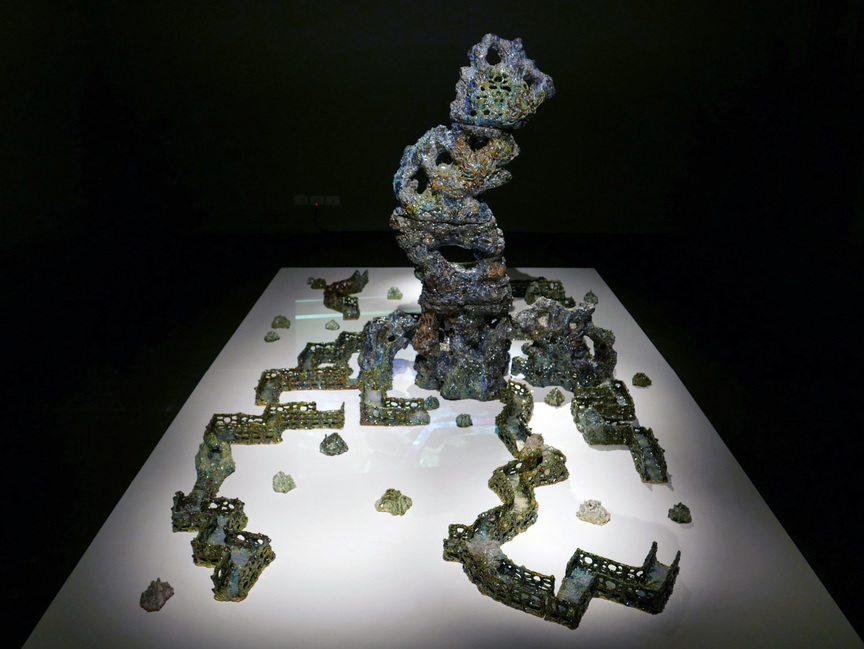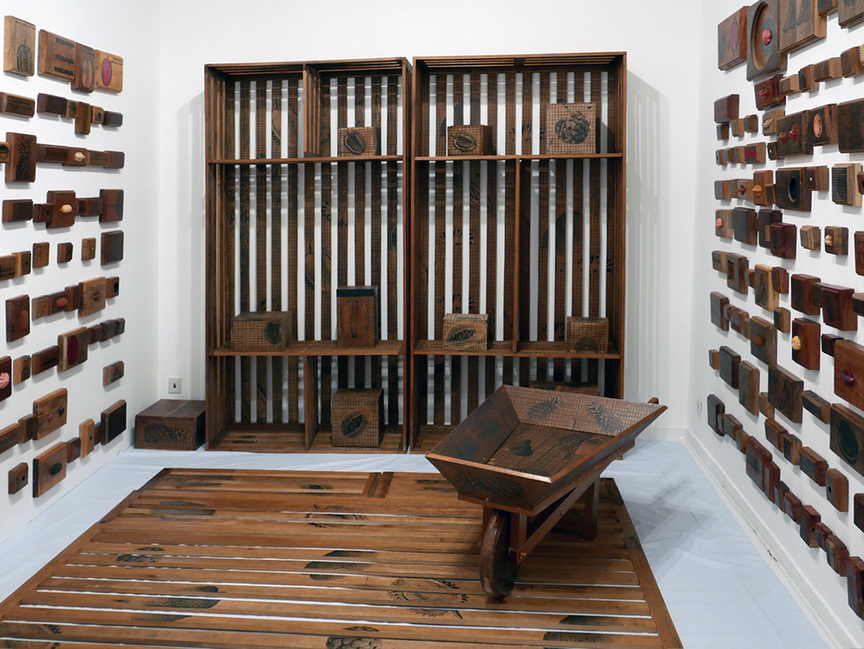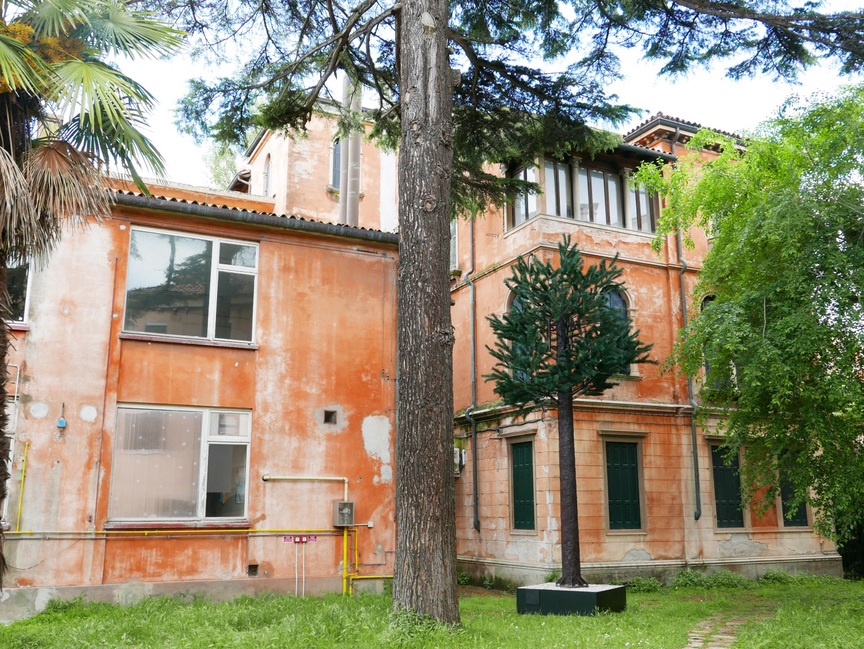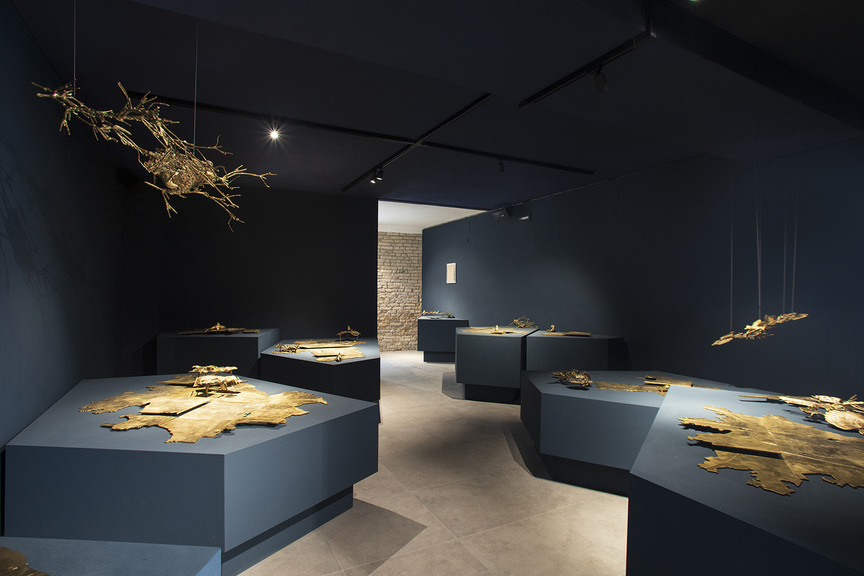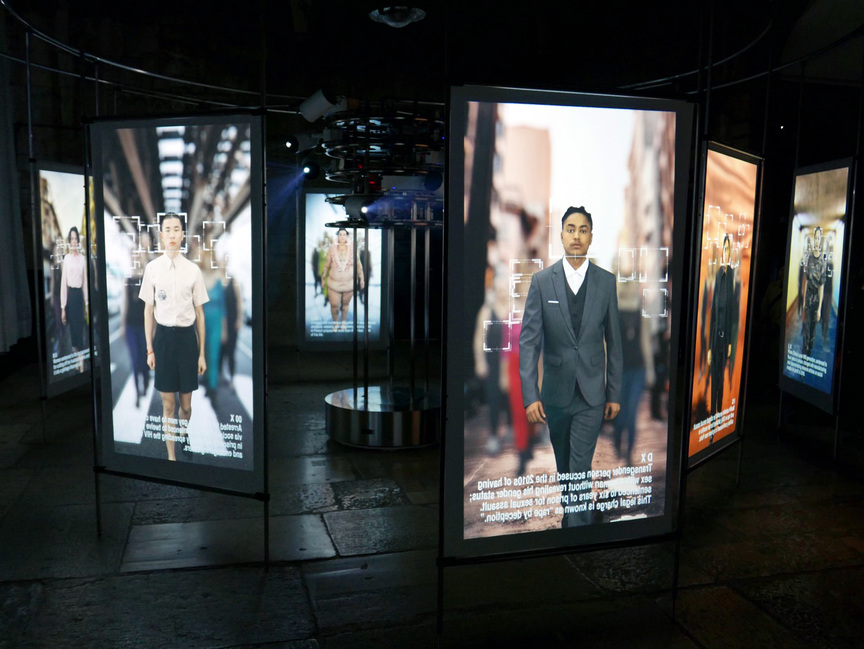
R
E
V N
E
X
T
Exterior view of the Pakistan Pavilion at the 58th Venice Biennale, 2019. Courtesy La Biennale di Venezia.
Outside the walled compound of Venice’s Arsenale shipyard and the leafy expanses of the Giardini are dozens of national pavilions and collateral exhibitions, spanning the island or located on nearby islets. These peripheral exhibitions, reflecting geopolitical hierarchies through the Venice Biennale’s system of pavilion assignments, are where the huge diversity and extent of global art production becomes most evident, with exhibitions by countries from South and Latin America, Africa, smaller nations of Europe, and the Asia-Pacific. One such geopolitical reality is that because of the People’s Republic of China’s involvement with the Biennale, the Special Administrative Regions of Hong Kong and Macau are not permitted to call their respective presentations at Venice “national pavilions.” Similarly, the Venice Biennale bars Taiwan’s participation as a “national pavilion,” relegating it, like Hong Kong and Macau, to the status of a “collateral exhibition.” Here’s a look at seven notable national pavilions and collateral exhibitions from across Asia.
Detailed installation view of SHIRLEY TSE’s Negotiated Differences (2019) at the Hong Kong Pavilion, 58th Venice Biennale, 2019. Photo by HG Masters for ArtAsiaPacific.
Hong Kong
Shirley Tse
“Stakeholders”
Shirley Tse’s exhibition for the Hong Kong Pavilion, titled “Stakeholders” and curated by Christina Li, combines the artist’s longstanding interests in the production and circulation of objects with her memories of her native Hong Kong. Greeting visitors in the spacious courtyard is the sparse installation Playcourt (2019), comprising 14 sculptures—several of them resemble anthropomorphic heads made from diverse plastic or synthetic materials—mounted on tripods and other stands arranged in two (barely discernable) rows in front of metal bleachers. Riffing on the makeshift badminton courts of her youth, Tse placed wooden badminton racquets on each side, while several of the sculptures are short-wave radio antennas aimed at the sky to catch amateur broadcasts. Inside, the installation Negotiated Differences (2019) is a rhizome-like structure of hand-hewn wooden pieces and 3D-printed connectors that extends through the three interior rooms. Among the wooden pieces, stained in different colors and many resembling table legs, are some components carved to resemble familiar objects, including bowling pins, a racquet, a recorder (an instrument that, by strange coincidence, played starring roles in the Singapore and Japan pavilions), an oar, Constantin Brancusi’s tower, a baseball bat, and a gavel. The materiality of the work—the variety of shapes and colors, and how the pieces are balanced—is of interest at first, but by the third, and largest room, the rhizome disperses and loses density and complexity, and with that, its impact. For all the artist’s interest in materials, the works are richer and more poetic in imagination (and in the curatorial texts) than in the actual experience of them.
Detail of SERWAN BARAN’s The Last Meal (2019), on view in “Fatherland” at the Iraq Pavilion, 58th Venice Biennale, 2019. Photo by HG Masters for ArtAsiaPacific.
Iraq
Serwan Baran
“Fatherland”
Brutal and concise is the Iraq Pavilion, presented by the Ruya Foundation, with two works by the Iraqi-Kurdish artist Serwan Baran. Forty years of war in the country is the subject of “Fatherland,” as Baran, who was a soldier and war artist, draws on his experiences of recording Iraqi victories for military propaganda. The sculpture The Last General (2019) is a camouflage-green-painted, life-size replica of an army general in a boat lying on the floor. The body appears to be decaying, and, dressed in the fabric of actual military uniforms, the general resembles an ancient mummy rather than a heroic figure. In a second room is a expressionistic, wall-sized painting The Last Meal (2019), depicting a bird’s view of murdered soldiers (seemingly by gas or toxin given their fetal curls) during a mess, and also incorporates metal dishes and elements of fabric from the military uniforms of those who have served in the Iran-Iraq War, the second Gulf War, and in fighting ISIS. At first, it resembles a wall of camouflage, before the huddled figures reveal themselves. Collectively, Baran’s works in “Fatherland” are intended to be a critique of the nationalist and religious ideologies that are deployed to motivate and justify war, and to illustrate that soldiers themselves are often the victims of brutal authorities. Fair enough, as the horrors of war are ongoing in Iraq and elsewhere in the world, though the perspective of those fighting them is rarely heard much less presented as nuanced. To be reminded of their struggles is rightfully an unpleasant experience, which Baran successfully achieves, particularly through the immersive scale of The Last Meal.
Detailed installation view of HEIDI LAU’s The Nine-Turning Zigzag Bridge (2019) at the Macau Pavilion, 58th Venice Biennale, 2019. Photo by HG Masters for ArtAsiaPacific.
Macau
Heidi Lau
“Apparition”
The ceramic sculptures by Heidi Lau in the Macau Pavilion, titled “Apparition” and curated by Sio Man Lam, are rooted in local folk beliefs, central to the lives of a little-seen population in the Special Autonomous Region of China who number 600,000, while annual visitors top 30 million (the situation is similar to Venice’s own resident-tourist dynamic). Now based in New York, Lau draws on Taoist mythologies, beginning in the courtyard with a series of roughly hewn, totemic heads of the goddess Nüwa. The second part of “Apparition” features the blue-, white-, and black-glazed, over-one-meter-tall figure The Elderly with Palm Leaf Fans (2019), which has sprouted three black palm fans that mechanically flap up and down. A third room stars People Mountain People Ocean (2019), which looks like the tail of a beast whose back is populated with little white, ghost-like figures, and was inspired by an ivory carving that Lau saw on a visit to a casino’s art collection. The penultimate room is titled “Reflective Nostalgia: The Old Recreation Garden,” and holds the large ceramic installation The Nine-Turning Zigzag Bridge (2019), comprising green-glazed miniature walkways and a scholar’s rock-like form based on those from Lou Lim Ieoc Garden, a public park that was originally the private estate of Macau’s first casino mogul. In the corner is Song of the Exile (2019), a stack of ceramic cages from which emanates incense and excerpts of arias from Cantonese operas performed by an amateur singer—a former Macau resident who moved to the United States long ago. With Lau’s uniquely beautiful-grotesque, Taoist-inspired sculptures, “Apparition” is a plaintive, and consciously nostalgic tribute to the city’s past and its invisible culture.
Installation view of ZULKIFLI YUSOFF’s Kebun Pak Awang (Mr Awang’s Garden) (2010) at the Malaysia Pavilion, 58th Venice Biennale, 2019. Photo by HG Masters for ArtAsiaPacific.
Malaysia
HH Lim, Zulkifli Yusoff, Anurendra Jegadeva, and Ivan Lam
“Holding Up a Mirror”
Curated by Lim Wei-Ling with Gowri Balasegaram, “Holding Up a Mirror,” the first Malaysia Pavilion at the Venice Biennale, introduced four male artists—HH Lim, Zulkifli Yusoff, Anurendra Jegadeva, and Ivan Lam—looking at different aspects of Malaysian history, identity, and culture. The most senior figure is Lim, a neo-conceptualist who has been based in Rome since 1976, and is represented by a series of video-performances, including one showing him with his tongue nailed to a table, and another of him balancing on a basketball. A collection of 28 chairs, Lim’s Sitting Sculptures (2019) fills the main room, facing a triptych, Four Seasons (2019), that comprises a mass of floating symbols representing the conjunction of episodes in history and the artist’s career. Yusoff’s room-sized installation of wooden objects painted with images of fruits and vegetables overlaid by grids, Kebun Pak Awang (Mr Awang’s Garden) (2010), harkens back to prime minister Tun Abdul Razak’s 1974 agricultural initiative to encourage domestic production, as well as to earlier colonial efforts to catalogue and codify local species and populations. Working, like Lim, with a postmodern approach, Jegadeva’s Yesterday, In a Padded Room (2015) features a pair of gaudy thrones, a carpet bearing an old map of Southeast Asia, and walls covered with cushions printed with the faces of Malaysian and international figures from politics and popular culture, in a dizzying montage of Southeast Asian history. The installation of Lam, the fourth and youngest artist, is titled One Inch (2019), and comprises 19 monitors facing the wall, denying viewers’ sightlines to the Malaysian films from the 1960s to the present—a reflection of the country’s history—which are reduced to a chorus of white noise and a white glow. The historical groundwork of contemporary figures and subjects was laid out in the pavilion, with artists hailing from Malaysia’s diverse communities, and representing a range of artistic approaches. It will be interesting to see where Malaysia goes with its next national pavilion.
Partial view of DANE MITCHELL’s “Post Hoc,” outside the Palazzina Canonica, 58th Venice Biennale, 2019. Photo by HG Masters for ArtAsiaPacific.
New Zealand
Dane Mitchell
“Post Hoc”
“Post Hoc,” (meaning “after this”), curated by Zara Stanhope, is Dane Mitchell’s memorial to the extinct. For eight hours a day for the entire seven-month duration of the Venice Biennale, an electronic voice inside a soundproof chamber at the Palazzina Canonica announces millions of names of things that no longer exist. More than extinct species, there are dialects and languages; models of cameras; film stocks; artworks; calendars; literary works; and capitals, colonies, and nations on this list. From within the Palazzina, the voice is transmitted to cell towers resembling trees, one located in the garden outside and at three other sites in Venice. A small speaker, embedded in the artificial trees, broadcasts the inventory, like some kind of prophetic wisdom tree. Upstairs, inside the Palazzina, a printer is continuously reeling off the list on scrolls of paper that will gradually fill the wooden library that has been emptied of the scientific books about maritime subjects that it usually houses. While the project has an ecological bent, given the mass extinction of plants and animals we humans are currently causing on the planet, it’s also an index of capitalism’s cycles of creation, planned obsolescence, and destruction—even artificial trees are a relic from an earlier moment of cellular technology. The trees themselves are placed at sites of research (the university and a historical hospital), technical knowledge production (the ship-building area of the Arsenale), and loss (next to trees in the Giardini marking fallen soldiers from World War I). Yet Mitchell’s treatment of the material is entirely, and even neurotically, neutral. The list is alphabetical; the voice reading it is mechanical; its scale beyond human comprehension or retention. The production of this list is itself a testament to human ability and perspective—after all, we originally produced the identities of these lost phenomena, and today still know their names, even if they have vanished. Presumably, like staring into the night sky, what we experience in “Post Hoc” is only a sliver of a potentially infinite quantity. The dark matter of the universe remains unknown to humans in the first place and therefore unable to be lost.
Pakistan
Naiza Khan
“Manora Field Notes”
The inaugural Pakistan Pavilion at the Venice Biennale was spearheaded by curator Zahra Khan and presented a new body of works by Naiza Khan (the curator and artist are not related) on the artist’s abiding interest in the island of Manora, off the harbor of Karachi. A neglected and little-known place to most residents of Pakistan’s largest city, Manora has fascinated Naiza Khan as a concentrated location of social and ecological histories, many of which are being erased. Home to Christian, Hindu, and Muslim religious sites, the island reflects South Asia’s pre-Partition cultural diversity, and it has been a location for naval defense from the 17th century through today, as the Pakistan Navy is now the island’s primary occupier, while local populations slowly disperse to the mainland. The first part of the project is the installation Hundreds of Birds Killed (2019), which is based on a 1939 document, the India Weather Review, found in 2009 by the artist at the dilapidated Manora Weather Observatory. The document reviews the aftermath of storms across British India, and includes the former names of places that span three nations today. In the gallery, a woman’s voice narrates this report. Situated on plinths is a series of brass sculptures in the shape of cities in the report, with networks of streets incised into their surfaces, and which are combined with small figures, such as that of a whale, birds, and airplanes, related to Manora’s history and ecology. In the courtyard, Doorbeen (Telescope) (2019) is an artisan-crafted device that plays videos of scenes from Manora through its lens. The craftspeople who collaborated with the artist on the work, and who produce metal telescopes from scavenged parts that are set up on Manora’s beach, are figured in the four-channel video installation Sticky Rice and Other Stories (2019). These artisans’ other craft is producing models of ships, which visitors see in the video as a man pushes one of the models on an illuminated cart along the beach after dusk. Elegiac in tone, the videos beautifully encapsulate how Manora (as a microcosm for Karachi and Pakistan at large) exists outside of, and also within, contemporary economies of time, speed, technology, modern nationhood, and modernization, with the weight of colonialism and contemporary ecological degradation serving as a dragging anchor on its populations. Here, Manora becomes a synecdoche for much of the postcolonial world today.
Installation view of SHU LEA CHEANG’s “3×3×6” at the Taiwan Pavilion, 58th Venice Biennale, 2019. Photo by HG Masters for ArtAsiaPacific.
Taiwan
Shu Lea Cheang
“3×3×6”
At the entrance of the Taiwan Pavilion collateral exhibition, after the carnival-like ticket booth staffed by a bald mannequin in a pink shirt, there’s a sign warning visitors to the Palazzo Delle Prigioni that they will be recorded on a surveillance system designed by the artist Shu Lea Cheang. Upstairs in the main space of the former prison, the exhibition “3×3×6,” curated by Paul B. Preciado, features ten screens hanging in two concentric circles around a column of camera-like projectors. Faces from the footage of the pavilion’s visitors and selfies submitted via the internet are superimposed on the images playing on the screens, which feature people walking down urban streets. In the two adjacent spaces are ten monitors on the floor playing short videos based on historical and contemporary subjects who were incarcerated because of “gender or sexual dissent,” including Giacomo Casanova, Marquis de Sade, Michel Foucault, and a man in Germany who ate another man (by consent) after having sex with him, and three women from Zimbabwe who were allegedly raping and stealing men’s semen. These narratives are obliquely portrayed through often sexually explicit vignettes and animations that range in tone from absurd to darkly comedic, pornographic to fetishistic. The format of standing and looking down at the monitors with tangled headphones attached to the floor wasn’t ideal for watching the videos, but moving between them, you got a strong sense of Cheang’s unique techno-pop, “trans punk fiction[al]” aesthetic. Her ability to bridge discourses around gender, queer sexuality, AI, the surveillance state, and anti-colonial positions through her filmmaking skills and technical prowess made “3×3×6” one of the most original and compelling pavilions of the 2019 Venice Biennale.
HG Masters is the deputy editor and deputy publisher of ArtAsiaPacific.
The 58th Venice Biennale is on view at various locations in Venice until November 24, 2019.
To read more of ArtAsiaPacific’s articles, visit our Digital Library.
